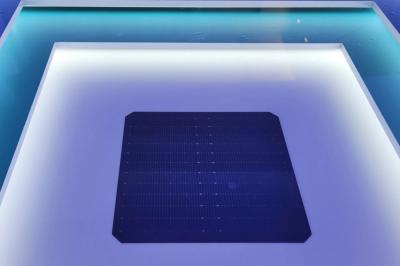Hanwha Solutions Qcells Division (Hanwha Qcells), a global leader in complete clean energy solutions, has announced a new world record, reaching 28.6% for tandem solar cell efficiency on a full-area M10-sized cell that can be scaled for mass manufacturing. This result was achieved despite having only begun large-area tandem development in 2023.
“The tandem cell technology developed at Hanwha Qcells will accelerate the commercialization process of this technology and, ultimately, deliver a great leap forward in photovoltaic performance,” said Danielle Merfeld, Global CTO at Hanwha Qcells. “We are committed to advancing the next generation of solar energy efficiency and will keep investing significantly in research and development to drive progress in this field, as every kilowatt counts on the path to building a more sustainable future.”
Hanwha Qcells’ 28.6% certified record efficiency, independently verified by the CalLab at the Fraunhofer Institute for Solar Energy Systems (ISE), brings the industry one step closer to commercializing solar technology that is more powerful and affordable. Hanwha Qcells’ new record for tandem solar efficiency is based on perovskite technology of the top cell and proprietary Q.ANTUM technology of the bottom cell. The value is a total-area measurement on a full-area M10-sized (roughly 0.36 square feet or 330.56 cm2) cell using a standard industrial silicon wafer that can be interconnected into an industrial module. This approach to tandem development focuses on commercial processes and tools that readily scale to mass manufacturing, rather than attempting to show a proof of concept in a lab-scale environment.
Hanwha Qcells’ stacking of a perovskite top and silicon bottom solar cell to form a tandem cell improves performance by capturing high energy light more efficiently through the top cell while low energy light is transmitted and captured by the bottom cell. This improves the power per area, meaning that fewer modules are needed to achieve the same solar system power output. This breakthrough has the potential to further reduce the cost of solar energy and the land footprint needed for solar projects, making solar even more affordable, accessible, and sustainable.
Hanwha Qcells’ R&D teams have been working since 2016 to develop a commercially viable tandem solar cell based on perovskite top-cell technology and the company’s proprietary silicon bottom-cell technology. Hanwha Qcells significantly boosted its efforts to realize this next-generation solar product with the launch of a dedicated research center in Pangyo, Korea, in 2019, building on the company’s well-established R&D foothold in Bitterfeld-Wolfen, Germany. Following a series of R&D feats in developing highly efficient small-area tandem solar cells, Hanwha Qcells has pivoted its focus to large-area tandem development, which led to this new world record efficiency for a tandem solar cell.
Hanwha Qcells’ Pangyo R&D center, appointed as a research institute for national projects, has received ongoing support from the Korean government to develop commercially viable tandem cell technology. The Bitterfeld-Wolfen R&D center in Germany is embedded within the company’s global R&D partner network, which is supported by funding from the German government, the state of Saxony-Anhalt, the EU Commission, including the lighthouse project PEPPERONI, and the Dutch and Swiss governments. The work leading to this record efficiency tandem cell achievement was partially funded by the German Federal Ministry for Economic Affairs and Climate Action (BMWK), the state of Saxony-Anhalt, and the EU Commission.
“We are fortunate to have outstanding global R&D teams and to have received invaluable support from our partners in Korea and Europe, leveraging their resources and expertise. We deeply appreciate everyone dedicated to driving innovations that bring us closer to achieving our climate goals,” said Danielle Merfeld, Global CTO at Hanwha Qcells.
“Hanwha Qcells is excited to announce this new world record in tandem cell efficiency based on our in-house developed perovskite technology as a top cell, and cost-efficient Q.ANTUM silicon technology as a bottom cell. The champion cell is a typical cell from our R&D pilot line in Germany and has been fabricated exclusively using processes that are feasible for mass production. This result is laying the groundwork for future commercialization of this exciting technology,” said Robert Bauer, Head of Hanwha Qcells R&D in Germany.




